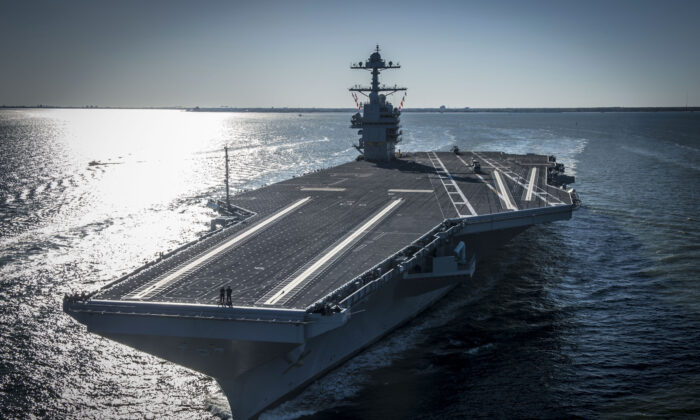Russia Frees US-Israeli Woman Jailed in Drug Bust After Putin Pardon
A question mark hangs over the future role and numbers of U.S. aircraft carriers the Acting Secretary of the Navy indicated, as he said the force will shift to a fleet that relies less on the military muscle of large ships.
Acting Secretary Thomas Modly remained tight-lipped on the details of the long-awaited Navy outfitting strategy which he said he will deliver to the Defense Secretary this week. However, he told the audience at the Center for Strategic and Budgetary Assessments on Jan. 29 that the Navy planners are shifting their fleet requirements toward a long-mooted strategy: distributed operations.
Distributed operations is the solution to the problem of China gearing much of its firepower, tactics, and technology towards nullifying the once indomitable U.S. air carriers—essentially floating airfields—and larger ships.
 Acting United States Secretary of the Navy Thomas Modly testifies before the Senate Armed Services Committee in the Dirksen Senate Office Building on Capitol Hill on December 03, 2019, in Washington. (Chip Somodevilla/Getty Images)
Acting United States Secretary of the Navy Thomas Modly testifies before the Senate Armed Services Committee in the Dirksen Senate Office Building on Capitol Hill on December 03, 2019, in Washington. (Chip Somodevilla/Getty Images)The U.S. military is revamping across the board to face renewed “great power competition” with Russia and China. The more fleet-footed Army and Marine Corps have already submitted their modernization plans, but the Navy–with its slower-turning industrial base—has yet to realign.
In the Pacific, China’s layers of long-range precision missiles designed to hold the U.S. Navy and its jets at arm’s length have left strategists with a headache. Some analysts say that the U.S. packing so much military muscle in a few key ships was once an advantage, but is now a strategic weakness–that the U.S. Navy has its eggs in too few baskets.
Current law binds the Navy to strive for 12 aircraft carriers—although Modly said that won’t actually be achieved until 2065 at current planning.
“The big question, I think at the top of the list, is the carrier,” said Modly. “What’s the future carrier going to look like and what’s the future carrier mix going to look like? These are really, really expensive assets.”
The latest U.S. carrier, for example, cost $13 billion.
“Of course, we’re developing all kinds of things to make it less vulnerable, but it’s still a big target,” he said. “And it doesn’t give you that distribution that I think we want.”
Modly was speaking at a launch event for a CBSA analysis (pdf) of the needs of a future Navy fleet.
“During the nearly 30 years since the end of the Cold War, navies encountered relatively permissive environments, and the threats they did face could largely be defeated by improved defensive systems,” said the report introduction. “A new generation of challenges has emerged, however, including ubiquitous passive sensors, quiet submarines, supersonic and hypersonic anti-ship missiles (ASM), “smart” mines, and the increasing use of paramilitary forces in naval operations.”
Many other navies have long since revamped their fleets and strategies to adjust, said the report.
Modly said that the United States needed to have a “national discussion” about the changes needed. “Congress obviously has interests; our shipbuilding industry does as well. We all do. We want to have a strong shipbuilding industry. We want to be able to continue to produce those carriers—they’re important.”
Modly said he was not able to talk about the details of the force structure assessment, but indicated the overall shift in direction.
“There’s some general themes that are going to be very consistent no matter whose analysis you look at. Distributed [operations] is one of them. We’re going to have to build a fleet that’s more distributed to support distributed maritime operations. We’re going to have to build a fleet that has distributed sensor capability. We’re going to have to build a fleet that’s less concentrated in its lethality. We’re going to have to build a fleet that per-platform is less expensive than it is now.”
The Navy is currently locked into a 355-ship goal, which may hamstring a shift to a more distributed model or a reshaping of the force.
For those who assess the Navy’s prowess by counting ships, the distributed operations strategy complicates things further by throwing a number of unmanned vessels into the mix. Congress has indicated that it will not include these in its current way of counting, said Modly.
The use of unmanned platforms is being considered more across the military. They allow the kind of distribution of sensors and weapons away from fewer key points of failure and are also relatively expendable.
Modly noted that the average cost of a new ship in the 1980s–when the Navy had a 600 ship goal—was about $1 billion, whereas the average cost now is $2 billion.
“It’s just not sustainable anymore,” he said.
This article is from the Internet:Navy Needs ‘Distributed’ Fleet, Says Acting Secretary—Hints At Fewer Carriers
